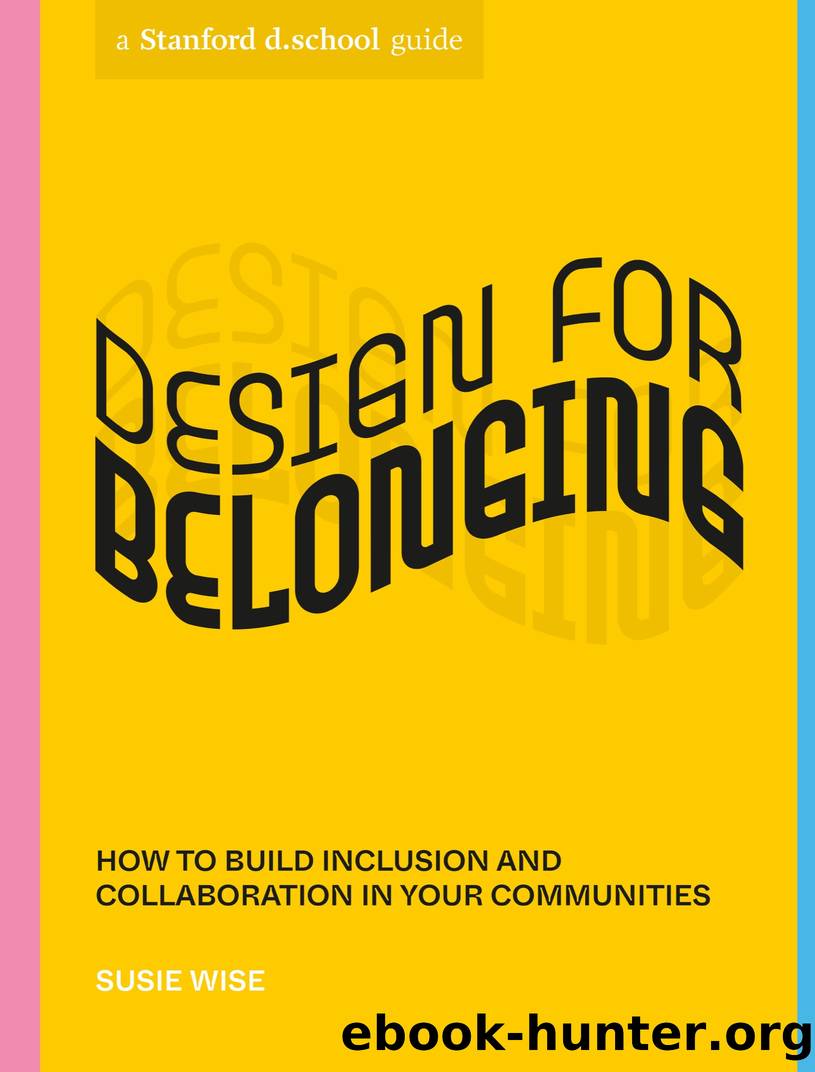Design for Belonging: How to Build Inclusion and Collaboration in Your Communities by Susie Wise & Stanford d.school

Author:Susie Wise & Stanford d.school [Wise, Susie & Stanford d.school]
Language: eng
Format: epub
ISBN: 9781984858030
Publisher: Clarkson Potter
Published: 2022-04-19T00:00:00+00:00
Space
Skate park, hotel lobby, mosque. Space is used to construct who is in and who is out. The way a space flows and forms indicates what skills and knowledge are required to enter and to succeed and whether we are allowed to make mistakes. Space can also tell us how to play and what mischief we can make. It offers behavioral clues and cues for how to show up and who is really wanted. You can consciously design a space to be welcoming and inclusive, or you can neglect toâat your peril.
Skate parks are a powerful example of spaces that allow for authentic learning and clear ways into a community. They are obviously not for everyone. But for folks interested in skating and riding BMX bikes, they offer a layered way to practice a craft. Show up and watch or jump in and rideâboth are acceptable approaches and part of the learning journey. Admission is usually free, but use of the space is practically dependent on having the gear required: board, bike, helmet, and pads.
Skate parks offer some noticeable ways a space can be crafted for belonging: There are multiple perches for watching and learning, and usually multiple ramps and bowls for different skill levels. As my friend and skate shop owner Patrick told me, the park âis made so you can roll up and see whatâs happening, then drop in when you are ready.â
As much as I love a skate park as a multilayered learning environment, you have to look hard for spaces that offer truly inclusive play, especially for children with disabilities. An excellent model for an explicitly inclusive play space is the Magical Bridge Playground in Palo Alto, California. Designed with a broad mandate to include children with a range of physical and mental abilities, along with their caregivers, its website says its features âare friendly to people with visual impairments, autism, and cognitive disabilities.â It also has room for wheelchairs, walkers, and other assistive devices. These features include a slow-moving swing for children who are anxious, a wide ramp with graspable shapes and colors for children who need assistance with climbing, and a harp that is triggered to play when you pass by, to spark joy and curiosity for whoever is able to notice it. There are so many more things to touch, hear, and maneuver than in a traditional playground. As a result, the team that built it has found it to be incredibly popular with a wide range of children and their families, showing that playing together across abilities can be the most fun.
Space considerations can also be subtle. In Whistling Vivaldi, social psychologist Claude Steele shows how space can be permeated with cues for belonging (and othering), particularly for underrepresented groups. Through his own story of not being sure he belonged in graduate school as the one Black doctoral student in a program of more than a hundred and through his subsequent research, he establishes the existence and disabling power of stereotype threat:
Download
This site does not store any files on its server. We only index and link to content provided by other sites. Please contact the content providers to delete copyright contents if any and email us, we'll remove relevant links or contents immediately.
| Ethics | Etiquette |
| Fashion & Image | Health & Stress |
| Motivation & Self-Improvement | Work Life Balance |
| Workplace Culture |
Tools of Titans by Timothy Ferriss(8305)
Change Your Questions, Change Your Life by Marilee Adams(7684)
Deep Work by Cal Newport(6966)
Playing to Win_ How Strategy Really Works by A.G. Lafley & Roger L. Martin(6084)
Man-made Catastrophes and Risk Information Concealment by Dmitry Chernov & Didier Sornette(5956)
Digital Minimalism by Cal Newport;(5704)
Big Magic: Creative Living Beyond Fear by Elizabeth Gilbert(5677)
The Slight Edge by Jeff Olson(5376)
Ego Is the Enemy by Ryan Holiday(5347)
The Motivation Myth by Jeff Haden(5175)
The Laws of Human Nature by Robert Greene(5080)
Stone's Rules by Roger Stone(5052)
Tuesdays with Morrie by Mitch Albom(4732)
Eat That Frog! by Brian Tracy(4483)
Rising Strong by Brene Brown(4411)
Skin in the Game by Nassim Nicholas Taleb(4203)
Bullshit Jobs by David Graeber(4140)
The Money Culture by Michael Lewis(4134)
Skin in the Game: Hidden Asymmetries in Daily Life by Nassim Nicholas Taleb(3961)
